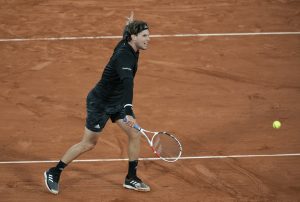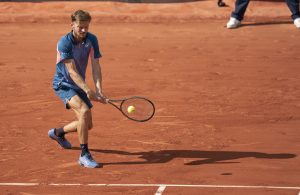The announcement by the International Tennis Federation that the Olympic men’s singles final will be reduced from five sets to three is further evidence, if any were needed, that best-of-five sets tennis is increasingly under threat. Five-set matches will now be played only at Grand Slam events and there may yet be calls to eliminate five-set matches at the Majors too. But those calls must be resisted if tennis is not to lose its soul.
The ITF justified this change, along with the decision to replace deciding sets in men’s and women’s doubles matches with a match tiebreak, on the basis of reducing concerns of overplay and fatigue for players who manufacture deep runs in more than one discipline. The irony is that in the process the ITF itself, which lobbied long and hard to have tennis readmitted to the Olympics after a sixty-year gap between 1928 and 1988, has reduced not only the length of Olympic finals, but also their status.
While men’s singles Olympic finals were played out over five sets, it was at least notionally possible to argue that winning an Olympic gold medal was an achievement comparable to winning a Grand Slam title. But now that gold medal matches will only be played out over three sets, some of the shine has surely been taken off the achievement, with an Olympic gold medal now perhaps more akin to a title at the ATP Finals.
If the Olympic singles final really had the same status as a Grand Slam final, there would surely have been no question of reducing it from five sets to three. But, in reality, the two feats have never been equal in the eyes of the tennis world. One suspects then, that a factor in this decision was the ITF’s desire to preserve the singular status of Grand Slam events. And with the US Open starting less than a month after the end of the Olympic tennis tournament in Tokyo, the ITF perhaps aims to reduce the risk of players injuring themselves or burning themselves out before play begins in New York.
Thus if the ITF’s Olympic decision was one taken in isolation, it would not have been an unreasonable move. However, the fact is that it is part of an increasing trend, even among tennis administrators and former players, to argue that the days of the five-set match should be numbered. Just over a year ago, for example, Billie Jean King, one of the greatest of all time and a founding member of the WTA, argued that all men’s matches should fall into line with women’s matches and be reduced to three sets.
She said that it should be done on health grounds, to protect players from long-term injury. King cited the example of the 2012 Australian Open final between Novak Djokovic and Rafael Nadal. At just under six hours, that match remains the longest Grand Slam final in history and, indeed, one of the greatest matches ever played. But King argued that it also took at least a year off the careers of both men, such was the brutality of the contest.
As yet, there is no evidence of that, as Djokovic and Nadal hold all four major titles between them and occupy the top two spots in the world rankings, despite both being in their 30’s. And even if King is right and such epic matches (both in intensity and duration) do shorten a player’s career, it is arguable that it is a price worth paying for a match that will live long in the memory as the defining clash in one of the greatest rivalries the sport has ever seen.
In the last year, Wimbledon has sensibly decided to introduce fifth-set tie-breaks at 12-12. It was a decision made, in part, to prevent a repetition of the 2018 semifinal between Kevin Anderson and John Isner, which the South African eventually won 7-6 6-7 6-7 6-4 26-24. It was an epic clash, but one that gave Anderson little chance of upsetting Novak Djokovic in the final, which he lost 2-6 2-6 6-7. The Australian Open, meanwhile, introduced final set championship tiebreaks at 6-6, a rather less sensible decision. But still one vastly preferable to doing away with five-set matches altogether.
There are two main arguments against reducing Grand Slam matches from five sets to three. The first is that it would represent a rupture in the continuous history of tennis, stretching back to the first Wimbledon in 1877. In the years since, it has been possible to broadly compare the champions of different eras, from William Renshaw in the 1880s to Bill Tilden in the 1920s to Djokovic, Nadal and Roger Federer in the present day, because they have always played in more or less the same format. If Grand Slam matches were one day reduced from five sets to three, that link with the past would be irreparably broken.
The second, and far more important, argument is that five-set matches are the absolute pinnacle of tennis. Indeed, tennis is a rare sport where matches do not have a definite ending point. And, not only can the matches stretch on for well-over five hours, there is no relief for the competitors involved, save the 90 seconds they are allowed at changeovers. That is why any man who can endure such a challenge, as Djokovic did in Melbourne in 2012 or as Nadal himself did at Wimbledon in 2008 when he finally beat Federer 9-7 in the fifth set, can claim to be not only the best tennis player in the world, but arguably the best sportsman.
And it is also why rather than reducing men’s matches at the Majors to three sets, the reverse should happen and women’s matches at the Majors should be increased to five sets, perhaps initially starting from the quarterfinals onwards, but eventually being extended to the whole tournament. Such a move would serve to eliminate the last great imbalance between the men’s and the women’s game, as well as providing spectators with the chance to watch more women’s tennis.
The great British film producer David Puttnam said in the 1980s of the advent of the home video ‘reduce the size of the screen and you reduce the size of the dream’. He was absolutely right. Although all the technological developments since the introduction of video have undoubtedly made it easier to watch movies, easier is not always better, and it is surely unarguable that the best way to watch a film remains on a cinema screen.
The same is true of tennis now. If the increasing number and volume of calls for the Majors to follow the example of the Olympics and have three-set matches only, then the great dream of tennis, a sport that is all at once a test of a player’s skill, mental strength and physical fortitude, will be lost forever.
Main photo:
Embed from Getty Images






